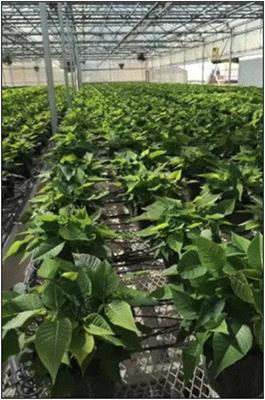The season is changing and it's time for a check-in. Keep your poinsettia production moving in the right direction with this week's tip.
PROBLEM: An ounce of prevention is worth a pound of cure, and this holds especially true for long-term crops like poinsettias. Make sure all the hard work you’ve put into your poinsettias so far pays off and keep your crop on track! Now that we’re about one week into natural short days (for northern growers), there are a few things that all poinsettia growers should keep on their radars to ensure things don’t fall off the rails.
NICK’S TIP: Right now, plants haven’t developed bracts and still need to put on a significant amount of size. As a result, it’s still relatively easy to spot pests and early symptoms of feeding damage. However, as the canopy tightens and plants fill out in the coming weeks, it will become difficult to scout thoroughly or achieve full canopy spray coverage with pesticides.

When you spot pest outbreaks at this point in the crop cycle, step on them quickly.
• Pest damage on leaves can be easily covered up by colorful bracts, but damage to young bracts now will magnify as they expand and it will be virtually impossible to hide at finish.
• Similarly, at this point in the crop cycle you don’t need to be as critical of spray residues on foliage or mild phytotoxicity resulting from an aggressive spray rotation. However, once bracts are formed and start to show color, the need to be extra careful with pesticide applications will become paramount.
• Scrutinize minor damage on leaves such as stippling, any small suberized (raised, corky) spots, or appearance of honeydew in the next couple of weeks. Don’t write off these early signs of pest-feeding damage—take a closer look at plants displaying these symptoms so pests don’t have an opportunity to establish a foothold.
• With cooler temperatures comes the annual influx of pests like whiteflies and thrips from the field. Stay vigilant and increase preventative biological releases or pesticide applications if you see a spike in either of these pests on your sticky cards.
This is also the time of year that occasional Lewis mite infestations start to become apparent. Due to their slower reproductive cycles (compared to their two-spotted spider mite relatives) and small size, if they slipped through the cracks, you may start to see damage in the next week or so. Be sure that you have a magnifying lens for scouting and act quickly if you find hotspots of these mites.
Check out our Lewis Mite Management document HERE for more info and guidance.
Ixnay on the Daminozide and Chlormequat Chloride
As a reminder, we are past the “do not apply after” date for daminozide (ex. B-Nine, Dazide) and are approaching the cutoff period for use of chlormequat chloride (ex. Altercel, Citadel) to restrict unwanted vegetative growth and internode stretch.
• As light levels decrease, and relative humidity and DIF (difference between day and night temperature) in the greenhouse increase, so too does your crop’s tendency to stretch. If it’s not possible to change environmental and crop cultural parameters sufficiently to curb this tendency, you may need to use plant growth regulators (PGRs).
• If you need to restrict growth with PGRs, it’s best to use paclobutrazol (ex. Bonzi, Piccolo, Paczol) at low concentrations like 0.10 ppm at this point. Foliar sprays can be applied but substrate drenches generally achieve a better whole-plant effect.
• Use of daminozide or chlormequat chloride at this point or later in the cycle could have adverse effects on color and cyathia development. Southern growers may be able to use chlormequat chloride for a couple of weeks still, but it’s best to err on the side of caution and switch to paclobutrazol from here on out.
Have a Bract Edge Burn Plan
While few growers have bracts forming on their poinsettias yet, think about how you will respond to signs of calcium (Ca) deficiency (aka “bract edge burn”) in your crop now.
• When bracts begin to expand and dominate the canopy, if relative humidity is high, soil stays too wet for extended periods, and/or Ca supply in your feed program is too low, this disorder may occur.
• Typical symptoms include blackening of bract tips and increased necrosis along the bract margin as they continue to expand.
• Ensure that you switch to—or incorporate—a fertilizer that provides additional calcium as the crop matures. If you don’t have any fertilizer like this on-hand, don’t get caught without any when you need it—order some now and have it ready to go!
• Similarly, it’s a good idea to keep some CaCl (calcium chloride) and wetting agent (like Capsil) on hand to supplement Ca via foliar sprays if needed. Ensure that you source high-quality CaCl because cheap sources may contain impurities that could cause phytotoxicity or leave residue on bracts.